Up Close and Personal With Kimchi
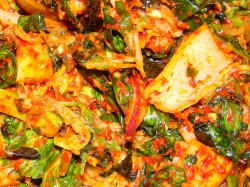
Kimchi is considered the national dish of Korea. This broad category of lactic-acid fermented pickles is made of a wide variety of vegetables, fruits and sometimes seafoods, all brined in salt, flavored with herbs, garlic, ginger, and often, liberal amounts of red chili peppers. Some people find the array of types of kimchi intimidating; I find them fascinating.
However, I must confess that while I adore kimchi, and am not intimidated by the thought of making it, until last night, I have been far too lazy to do it myself.
Which is odd, because it isn’t as if I am unfamiliar with the mysteries of fermented vegetables.
I mean, I grew up helping to make huge batches of saurkraut, kimchi’s blander (but still tasty) European cousin every autumn.
Mom and I would go out to Grandma and Grandpa’s farm on a drizzling, cool October morning, and help harvest bushel after bushel of cabbages. Mom, Grandpa, and Grandma would range up and down the rows, wielding machetes, which they used to hack the heads of cabbage off just above the damp red clay soil. With quick, deft cuts, the tough outer leaves would be trimmed, flopping to the ground waiting for me to scurry along and gather them into a basket. When the basket was full, it was my job to ferry it out to the field and dump them over the fence for the patiently waiting cows, who gladly grazed upon the parts of the cabbage which we found inedible. They found them delicious.
Uncle John would ferry the heavy, full bushel baskets of cabbages to the ends of the rows, where Grandpa would pick them up with the tractor, and he’d carry them to the house. Down in the basement we’d go, to cut the heads into quarters, core them and wash them very carefully in the big sink. We’d fill the sink with water, and then dissolve salt in it, and put the quartered cabbages in it to purge them of any bugs, slugs or other creepy-crawlies. Grandma was adamant that she didn’t want any extra added protein in her kraut.
Then Grandpa would shred the cabbage with his own mandoline, which he made out of a sharpened piece of machete blade, cut and mounted in an oak box he constructed. I was never allowed near the “kraut cutter” as he called it, as it was frighteningly sharp and had no safety features, unlike modern mandolines. My job was to take the shredded cabbage, bowl by bowl, and sprinkle the pale green ribbons into the huge forty-gallon crock in even layers. After about an inch of cabbage ribbons went in, Grandma would sprinkle the kosher salt over it all, in a proportion that her hands knew better than her head, and Mom or Uncle John would take up the “tamper”–a huge turned flat bottomed cudgel made of oak, once again by Grandpa–and beat the cabbage down, smashing it and releasing the juices, packing it tightly into the crock, forcing out the air.
This went on all day, until two or three huge crocks were packed full of pounds and pounds of salted cabbage. Then, Grandma would put a layer of cheesecloth over the opening of the crock, cover that with a clean dinner plate she had sanitized with boiling water, and on top of the plate went a carefully wrapped cinderblock which acted as a press, weighing down the cabbage, helping to extract the juice and keeping excess air out.
And that was it. We left it for a few weeks to ferment in the cold basement, and then Grandma would pack it into sanitized jars and process it in a hot water bath, and we’d end up with many quarts of delicious, nutritious saurkraut to keep us healthy all winter long.Making kraut is easy, but long and tiring work, especially if you make a large amount of it.
Kimchi, because it requires more ingredients than just cabbage and salt, requires more work still, though none of it is particularly hard. I made it in culinary school and loved it, but then, that was an entire class of twenty students making it. Many hands make the work lighter, you know, and until recently, I could only count on my own pair in the kitchen.
So, what was it that shook me out of my laziness?
Well, I was minding my own business, wandering through the farmer’s market on Saturday, and I saw this just cut head of napa cabbage. And it was huge–larger than Kat. And I could smell its fresh verdant sweetness from across the table, and it just looked lonely there, the last one left, bereft of its fellow cabbages. And I looked at it and thought to myself, “What a lonely looking cabbage. I bet it would make some fine and tasty kimchi.”
So, I bought the thing, which with the big, tough outer leaves weighed probably seven pounds, and lugged it home. Along the way, I also picked up some purple and pink radishes, some mustard greens, some tender new scallions, ome Japanese white globe turnips, some green garlic and some ramps (Appalachian wild garlic) to go in the kimchi. In fact, the only non-local ingredients that went into this kimchi were the fish sauce and chili peppers, the garlic and ginger and the kosher salt. In celebration of the fact that I was using mostly local Appalachian Ohio ingredients, including ramps (which, if they grew in Korea, would be used in kimchi–I just know it. They are so tasty, and so good that there is no Korean grandma who would turn her nose up at them. I am sure of it.), that I named this recipe, “Appalachian Springtime Kimchi.”
I figured that Morganna (also known as Chibichan) would help me make the kimchi, and since our kimchi jar was perilously low because I had been feeding it to her to fend off a cold, it seemed only fair.
As for a recipe, I will tell you the truth: I combined the recipe I found here, with one I read in the excellent cookbook, Eating Korean by Cecilia Hae-Jin Lee, and the method Chef Hector Lipa taught me at Johnson & Wales, added my locally grown and gathered ingredients and came up with my own concoction. Since I just made it last night, I won’t know for a few days how it is going to taste, but I will say it smells really, really good.
Kimchi, like saurkraut. is one of those foods which demands that you pay attention and get up close and personal with the ingredients. There is a lot of hand work involved in the making of kimchi, and because it is a fermented raw product, it pays to start out with very clean hands, utensils, counters and sink. So, scrub your hands well, clean under your fingernails and roll up your sleeves, then follow these step by step photographs chronicling our first batch of Appalachian Springtime Kimchi, a dish which I hope will become a seasonal specialty at our house. (Morganna wanted to name it “Redneck Kimchi” but I overruled that suggestion. To me, “Redneck Kimchi sounds like it was made from iceburg lettuce, Frank’s Red Hot Sauce, Vienna sausages and Blue Ribbon Beer. Ick.)
Appalachian Springtime Kimchi
Ingredients:
7 pounds Napa cabbage
1 cup plus 1 tablespoon kosher salt
2 heads garlic, peeled and sliced
4″ long chunk of fresh ginger 1″ thick, peeled and sliced
1 1/2 cups Korean ground red chiles
2 bunches scallions, trimmed, washed and sliced thinly (about a cup and a half)
1cup of ramp leaves, thinly sliced
3 fresh red chilies, stemmed and quartered
1 bunch of fresh mustard greens, washed and sliced into 1″ wide ribbons
1 bunch of radishes, washed, trimmed, cut in half and thinly sliced (about 1/2 cup)
3 medium sized Japanese globe turnips, peeled, trimmed, quartered and thinly sliced (about 1 cup)
1/4 cup fish sauce
1 teaspoon sugar
Method:
Gather your materials: you need a one-gallon jar, preferably glass, with a screw on lid or self-locking lid. Run it through the dishwasher and make certain to put it through the heat dry cycle. Or, wash it well by hand, then pour boiling water over it and the lid, then allow it to air dry. Also, you will need a very large bowl or basin and a large plastic bag. I used one of the giant Ziplock bags which are meant for storage of household items. It is tough enough to be rinsed out and used for later batches of kimchi.
You will also need latex or plastic gloves.
First, cut off the root end of the cabbage, and then strip away the tough outer leaves of the cabbage. Cut it in half longitudinally.
Then, making a v-shaped cut with your knife, cut the core of the cabbage, then pry it out with your fingers.
Separate all of the leaves of the cabbage, and carefully rinse each leaf individually, spraying away all of the little specks of dirt that like to hide out in the crinkly leaves. Pay special attention and watch out for ants, and especially slugs, which love to hide within the layers of the leaves and snack upon their sweetness. Slugs in kimchi are not my favorite thing.
Once the cabbage leaves are rinsed, cut them into about two-inch square pieces, and allow them to drain in a colander until all of the cabbage is cut. (Morganna would like me to mention at this point that all of this cutting, grinding and scrubbing goes well with music. She suggests that you listen to this. We did, and it had us dancing and bouncing as we chopped, shredded and ground our way around the kitchen.)
Then, you need to salt the cabbage. Open your plastic bag, and grab up some cabbage bits and sprinkle a thin layer into the bottom of the bag. Grab up a small amount of the one cup of salt, rub it between your palms, and then reach into the bag, and rub the salt into the cabbage leaves briskly. Repeat this process until you have used up all of the cabbage and salt, then squish the cabbage leaves, massaging the salt well into them.
Seal up the bag and set it aside for about three hours. Every now and then, check on the cabbage, swishing it around, and making certain that the cabbage juices that are being drawn out of it covers the leaves completely.
While the cabbage is brining, grind up your ginger and garlic with a food processor into a thick paste, and set them aside.
After the cabbage is brined, drain it in a colander, and squeeze as much of the juice out of the cabbage as possible. The texture should be similar to a dill pickle–soft but somewhat crisp.
Then, rinse the cabbage thoroughly with cold water, squeezing it and squishing it around, then allow it to drain again.
Put on your gloves, and mix together the remaining tablespoon salt, ginger, garlic, ramps, chili slices, and chili powder, fish sauce and sugar in the large bowl or basin. Get this mixed together well, then start massaging in the brined cabbage and mustard greens, in alternating handfuls. Please, please, please! Do not touch your nose, face, or any other part of your body with your gloved and chili infested hands. It is painful.
Mix thoroughly. Morganna and I found that putting the bowl into the sink kind of helps to keep the mess contained. We scrubbed the sink out well first so that if any bits escaped the bowl, we could just pick them up out of the sink and pop them back into the bowl.
After all the ingredients are squooshed into a big pile of kimchi goodness, it is time to start packing it into the jar.
Just scoop handfuls into the jar, and then gently pack them down in order to make sure there are no air bubbles. Don’t pack it tightly, it isn’t necessary.
After all of the kimchi is put in the jar, screw the jar on loosely. Strip off your gloves, then wash your hands thoroughly with soap and cold water, to remove any lingering residue from the chilies. Then, set the jar in a cool place and leave it alone for three days. Check it every day; if the fermentation is going correctly, you will see small bubbles moving up through the layers of vegetables.
After that, open it up and taste it, then store it in the refrigerator. It will last for a month or so, though it will continue to ferment. Some people do not like it as much after it ferments for a long time. I do like it, but some folks will only use very fermented kimchi in cooking, and will not eat it raw.
So, there it is. Appalachian Springtime Kimchi. Morganna and I are probably going to make a couple more batches of this while ramps are still in season, and give the jars away as gifts.
Stay tuned for more Korean recipes in the future, including some more kimchi varieties as the season progresses and other vegetables and fruits ripen.
33 Comments
RSS feed for comments on this post.
Sorry, the comment form is closed at this time.
Powered by WordPress. Graphics by Zak Kramer.
Design update by Daniel Trout.
Entries and comments feeds.

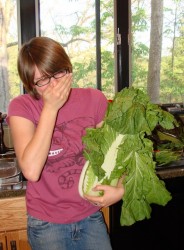
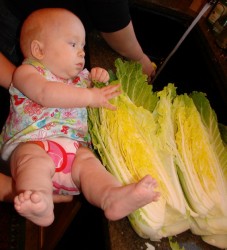
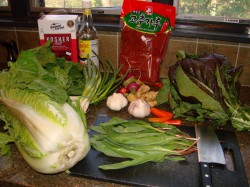
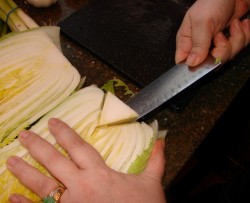
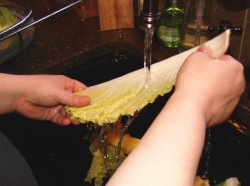
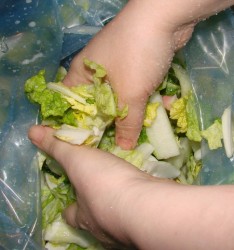
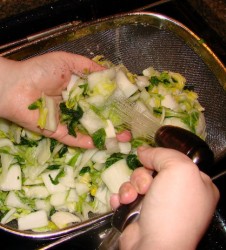
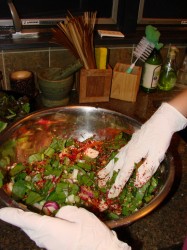
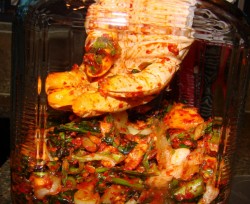
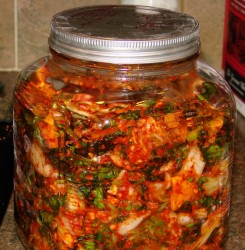


argh…I’m so jealous! Chicago farmer’s markets won’t start up til mid-May. We don’t have a year-round indoor market(see: Chicago politics)…and how I miss Columbus’s North Market. Anyway…you’ve inspired me to attempt kimchee this season. Thank you.
Comment by Christopher Gordon — April 30, 2007 #
I too live in a cold climate and it’s not local-eats weather here yet. I’m wondering if my German sauerkraut-eating, spicy-loving husband would be interested in this….
I love the leek-spinning song. It reminds me of the site I call ‘cool horses’ (http://svt.se/hogafflahage/hogafflaHage_site/Kor/hestekor.swf) although that’s interactive so you’d have to not be chopping things while listening.
Comment by wwjudith — April 30, 2007 #
Ooh, what timing! I just made your bulgogi burgers (to rave reviews) and was wondering what a good homemade kimchi recipe would look like. I would like to try this, though I think it’s more likely I’ll be picking up some kimchi at Ranch 99 soon.
Comment by Erin — May 1, 2007 #
Oh how I love, love LOVE Kimchi! This love for the fermented vegetables (cucumber kimchi is my personal favorite) is courtesy of my father who brought back some kimchi from Korea after one of his tours of duty when I was a kid. My husband says it stinks to high-heaven, but that just means there is more for me!
I buy it at my local Asian market once a week, but now I’ll try my hand at making it – especially since I have the ingredients to do it!
Comment by Maggi — May 1, 2007 #
Yay, kimchi! I would add that the nature of the red pepper powder is absolutely critical, and that to be Right it must be Korean. Also, that while salt is faintly les vital, it’s still pretty important, and I’d strongly recommend using coarse, damp, Korean kimchi salt. I speak not only as Mary Ann, but as ChunWooUmmah and SheeyunAnae.
Comment by Mary Ann — May 1, 2007 #
[…] Tigers & Strawberries » Up Close and Personal With Kimchi I like kimchi, but it’s not the kind of thing I ever think to buy when I’m in the Asian market (which isn’t very often). So maybe I should make my own. (tags: kimchi recipes koreanfood) […]
Pingback by Erin S. O’Connor » Blog Archive » links for 2007-05-01 — May 1, 2007 #
I’m amazed Barbara, your foodie childhood makes me green with envy!
Comment by Trig — May 2, 2007 #
I adore Kimchi but I can go to the local Korean Grocery Store and buy it right out of the barrel. Then, when I get it home, I add extra peppers because I like it Hot! Hot! Hot!
Comment by Nancy — May 2, 2007 #
I’m also a kimchi lover, but I never thought of making it myself. This looks quite manageable.
By the way, I saw your piece in Earthwatch Ohio–nice.
Comment by lucette — May 3, 2007 #
Mul gimchi (water kimchi) is also very nice and is suitable for impatient picklers… it only takes 3-7 days to come to full flavor, and the vegetables only need a little salt rubbing, a little sugar, some water, and some aromatics. (Chilies optional… there are many veriations)
Plus water kimchi is sippable, which I really like. And since it never seems to be for sale in the US, it’s actually easier to make than to buy. (Some of my recent blog entries from Korea show some examples).
Comment by Jason Truesdell — May 4, 2007 #
I LOVE it! I would never have thought to make my own. Amazing! I think I once read that in Korea they bury the pots underground while it ferments. I like your method way better.
🙂
Comment by Rachael — May 4, 2007 #
What a cool blog! While I have never made kimchi, I have often watched my mom make it and sometimes help her.
And as for burying kimchi underground – they did that a long time ago when there were no refrigerators! Kimchi takes a lot of work so people would make it in bulk and just bury it to keep it cool.
Comment by Patty — May 4, 2007 #
I forgot to add – please post what you will do next with the kimchi – you can make kimchijigae or kimchi bokeum!
Comment by Patty — May 4, 2007 #
Yeah, southern Ohio folks are lucky that we get farmer’s market goodies year round. Solar greenhouses and cold frames allow us to have fresh greens and roots all winter long. Not to mention mushrooms, stored apples, and stored tubers, pumpkins and squash. And meat and such.
Erin–it is fun. Try it when you have an afternoon to kill, though!
Maggi–this summer, look for a post on stuffed cucumber kimchi. I love the stuff, and I love the smell. I craved it like crazy when I was pregnant, and it killed my nausea! It was great then.
Mary Ann–I agree on the chile pepper. I used Korean, that was specifically packed and sold from the refrigerated section of my Asian market. It is marked for use in making kimchi.
The salt I couldn’t find, so I used kosher. Thus far, it tastes about right.
Trig–it is no wonder I grew up to be food obsessed with my family. One side of the family owned a meatmarket and slaughterhouse (done the old fashioned, humane way) and the other side were farmers. I learned all sorts of stuff most people my age didn’t grow up with.
It sometimes makes me feel like a refugee from the early twentieth or late 19th century, but I am grateful for it. And I miss my grandparents, too.
Lucette–I forgot to post here about that piece. Thanks for mentioning it. A reader of mine from Kent told the editor of Earthwatch about me and so she contacted me for that story. It was fun to work with them.
Jason–water kimchi is on my list of goodies to make, have no fear! I can’t wait to try it.
Rachael, the bury underground method was used back before refrigeration. It was used in the winter to keep the bulk kimchi from either being too warm in the house and spoiling or being so cold outside it would freeze. Buried below the earth, it kept at an optimum cool temperature to ferment just right. It was a primitive refrigerator, essentially. In the summer, back then, you buried it to keep it cold. (Or, you could keep it in a crock in a cold running stream.)
It is like the old root cellars we had back on my grandparents’ farm–using the insulating properties of earth to keep food at a constant cool temperature. We kept apples, potatoes, winter squash, carrots, pumpkins and turnips all winter that way, in a room underground.
Nowadays, in Korea, they have special fridges just for your home kimchi stock. It keeps it at the optimal temperature for fermentation. You can buy them in the US–I have seen them for sale at the Lotte Plaza in Ellicot City in Maryland. Pretty neato devices.
Oh, hey, Patty–we posted around the same time the explanation of the burying undergound. I definitely intend on posting more Korean food, including some dishes using kimchi as an ingredient. I am glad you liked this entry and I hope to see you again, soon.
Comment by Barbara — May 4, 2007 #
You’ll enjoy mul kimchi– it’s simple and refreshing, and not quite like anything else. 🙂
Comment by Mary Ann — May 5, 2007 #
It sounds wonderful, and I look forward to trying it out, Mary Ann.
Comment by Barbara — May 6, 2007 #
I’ve been wanting to make kimchi at home ever since my Korean friends in Scotland introduced me to it! Thanks for detailed instructions!!
Comment by Pille — May 7, 2007 #
Is that your baby wearing a g-diaper? And environmental conscious cook. Yeah!
Comment by Jennifer — May 7, 2007 #
Jennifer–why yes, it is a g-diaper! That is all she wears. I love them–they are great.
Comment by Barbara — May 7, 2007 #
Dear Barbara,
While shopping at a nearby Asian market, I purchased a small container of Kimchi. (I had been buying it at the health food store.) The woman at the check out asked me if I had ever had Kimchi fried rice, and then proceeded to tell me how to make it. I’m enjoying it for lunch right now. Have you ever made this? It is yummy and pretty cheap too.
Sue
Comment by Sue — May 9, 2007 #
[…] Tigers & Strawberries » Up Close and Personal With Kimchi Make your own kimchi at home. Love this stuff. (tags: recipe jen) […]
Pingback by The Zone Read » Blog Archive » links for 2007-05-09 — May 9, 2007 #
Try using the whole cabbage and salting it overnight, then drain, and rub spices in between the leaves. Then put in jar and ferment a day outside then in the fridge. Should good to eat after a few days.
Comment by melonbarmonster — June 4, 2007 #
Try using the whole cabbage and salting it overnight, then drain, and rub spices in between the leaves. Then put in jar and ferment a day outside then in the fridge. Should good to eat after a few days. You have to cut the kimchi before eating but the leaves will be crunchy fermented and delicious.
Comment by melonbarmonster — June 4, 2007 #
I love kimchi — the stinkier and hotter, the better. When I worked in DC there was a salad bar place that always had a big tub of kimchee on the buffet — now, don’t cringe…but I used to eat the kimchee with big hunks of feta cheese on top. My mouth is watering, just thinking about it. YUM.
Comment by Carol — June 9, 2007 #
linked.
Yum!
Comment by Tioedong — February 15, 2008 #
[…] Tigers (tags: recipe) […]
Pingback by links for 2008-04-11 « just links — April 10, 2008 #
Wow, I didn’t expect to find myself reading a non-Korean’s skillful kimchi recipe. I only stumbled upon your blog by searching for a bit of information of balsamic vinegar and now I am glad I got to know your blog. 🙂 In fact, as a Korean myself, I didn’t know how to make kimchi so far but I started to feel maybe I should give it a try with your recipe. Isn’t it ironic? Anyway, this is very impressive!
Comment by Veronica — April 20, 2008 #
Never had kimchee before, don’t even know what it is supposed to look or smell like. I’d like to try making it but I’m a bit wary though. Don’t wet vegetables grow dangerous bacteria? So the vegetables will still rot (ferment) but it is safe because of the salt? Will the finished product be super salty?
Comment by Mike — April 27, 2008 #
I live close to Ackron Ohio. Where is the nearest Korean Store to buy some kimchi and rice Thanks
Comment by george — October 31, 2008 #
Not knowing how to make kim chee;I saved the remaining juice from a store bought jar and poured it into a one quart jar.I then added cabbage.radishes.boc choy,green onions,garlic.jalapeno and chile peppers.kocher salt and palm sugar.I did not refirigerate for 3 days but kept it on a cool tile floor with the lid loose.When I eatsome,I fill in the void with more ingredients….
Comment by Don Clabeaux — August 13, 2011 #
[…] the morphology of milkweed bugs growing in a glass jar in my kitchen. I even made yogurt and kimchi, and learned to test the pH of both. The yogurt was edible; the kimchi was […]
Pingback by Goodbye Biology | Judy Budreau — October 17, 2011 #
Thank you for this blog, I love the way you explain how to make kimchi. You break it down step by step. Last night i made three jars of kimchi. Two jars of cabbage kimchi and 1 jar of cucumber kimchi. I am a American retired soldier.I was stationed in Korea in the early 90s and i aquired a taste for kimchi. I live in a place where there is quite a few Korean markets to by kimchi; However they kimchi has too much red peper in it and it is way too hot for my taste. I enjoy the fermentation and the sour ness of kinchi and not the heat. So i decided to make my own kinchi. I made some last year and just put a little bit of the red peper in it. It was awesome however i thought you had to put the red peper in it. I was talking to a Korean man the other day and we were talking about korean food. He said there was a white kimchi. He said you make it without the peper. So i did it last night. I bought 2 head of Napa cabbage,garlic,scallion,ginger,apple,carrots,radishes. I soaked my cabbage in kosher salt for almost three hours then rinsed it three times. I had mixed up the other item and had them waiting. Put it in mason jars and I have them stored in my back bedroom, i will leave them there for three or four days. Thanks again for your site it was really help full.
Thanks
Monty from S.C.
Comment by Monty Queen — November 20, 2011 #
I love kimchi but all my Korean friends act like you have to use a secret recipe handed down by countless Korean grandmothers to make it. I’m going to make a big batch this weekend using your recipe!
Comment by Terry — January 27, 2012 #